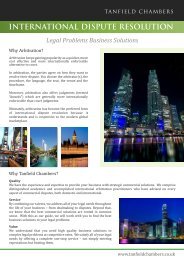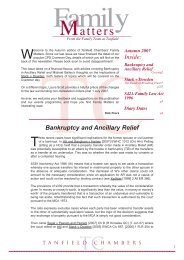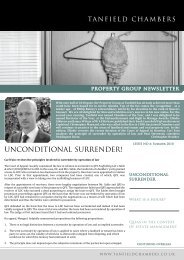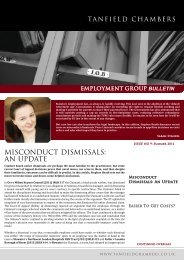Link to newsletter - Tanfield Chambers
Link to newsletter - Tanfield Chambers
Link to newsletter - Tanfield Chambers
You also want an ePaper? Increase the reach of your titles
YUMPU automatically turns print PDFs into web optimized ePapers that Google loves.
TA N F I E L D C H A M B E R S<br />
EMPLOYMENT GROUP BULLETIN<br />
Already a significant player in the London employment law bar, <strong>Tanfield</strong> Employment Group<br />
continues <strong>to</strong> expand. We are delighted <strong>to</strong> welcome Sarah Stanzel and Laura Robinson, who,<br />
<strong>to</strong>gether with Gemma de Cordova, have written articles for this edition of the Bulletin. In the<br />
case of GAB Robins v Triggs [2008] IRLR 317 referred <strong>to</strong> in the first article, Sarah and Laura<br />
acted for the Claimant in her employment and personal injury claims, respectively.<br />
We also welcome Iain Mitchell QC, of the Scottish Bar, who joins <strong>Tanfield</strong> as an associate<br />
tenant. Described by the direc<strong>to</strong>ries as a “genuine blue-skies thinker”, he is a member of the<br />
EHRC panel of Advocates and his varied practice includes some significant employment<br />
cases.<br />
Peter Linstead<br />
GUIDANCE ON DAMAGES<br />
Quantifying your clients’ exposure if they lose, or their likely winnings, is one of the most<br />
important aspects of an employment lawyer’s job. The last 12 months have seen some<br />
reductions in compensation limits due <strong>to</strong> a fall in the Retail Price Index, and a departure from<br />
the established practice of only altering statu<strong>to</strong>ry limits on 1st February. In addition, there<br />
have been several recent decisions affecting the way compensation is assessed in<br />
discrimination and unfair dismissal claims. Sarah Stanzel considers the recent developments.<br />
UNFAIR DISMISSAL<br />
As far as the basic award for unfair dismissal is concerned, on 1 Oc<strong>to</strong>ber 2009, instead of 1 February<br />
2010, there was a ‘one off’ increase of the limit on a week’s pay from £350 <strong>to</strong> £380. The maximum<br />
compensa<strong>to</strong>ry award dropped on 1 February 2010 from £66,200 <strong>to</strong> £65,300. There has also been an<br />
important recent decision on contribu<strong>to</strong>ry fault in Swallow Security Services Ltd v Millicent [2009]<br />
UKEAT/0297/08. The EAT held that if the tribunal find any conduct on the part of the claimant that<br />
might be regarded as blameworthy, the tribunal is bound <strong>to</strong> consider contribu<strong>to</strong>ry fault, whether or<br />
not the respondent raised it.<br />
ISSUE NO 7: Summer 2010<br />
GUIDANCE ON<br />
DAMAGES<br />
WHERE ARE WE WITH<br />
EMPLOYMENT STATUS?<br />
CONSTRUCTIVE DISMISSAL<br />
In GAB Robins (UK) Ltd v Triggs [2008] IRLR 317 the Court of Appeal made a surprising decision<br />
on damages where the employee says that the repudia<strong>to</strong>ry conduct (in this case bullying) caused the<br />
illness which was responsible for her ongoing loss of earnings. This loss cannot be recovered in the<br />
Employment Tribunal as it is not regarded as loss flowing from the dismissal. The claimant had <strong>to</strong><br />
pursue a claim for personal injury in the civil courts instead.<br />
continued overleaf<br />
W W W. T A N F I E L D C H A M B E R S . C O . U K
Sarah Stanzel<br />
Called in 1999, Sarah practises exclusively<br />
in employment law and regularly appears<br />
before the ET and EAT in a range of matters<br />
for both Claimants and Respondents. She<br />
has also appeared in the Court of Appeal<br />
including acting as junior counsel for the<br />
claimant in GAB Robins v Triggs [2008]<br />
IRLR 317. She increasingly receives instructions in cases with a<br />
cross-border or international element. Her languages include<br />
German, French, Italian, Spanish and Portuguese and she regularly<br />
advises clients both in the UK and abroad in their respective<br />
language, having undertaken work placements in law firms in<br />
Frankfurt, Paris, Rome, Madrid and Lisbon. She has recently<br />
travelled abroad <strong>to</strong> lecture before the Italian and Spanish<br />
Employment Lawyers Associations and at the Annual Conference of<br />
the European Employment Lawyers Association.<br />
RECENT MITIGATION DECISIONS<br />
In Islam Channel Ltd v Ridley [2009] All ER (D) 89 (Aug), the<br />
claimant obtained a freelance job at first better paid than her previous<br />
job but by the hearing it was less well paid, <strong>to</strong>tal earnings from<br />
dismissal <strong>to</strong> hearing being better than in the old job. The EAT held that<br />
past earnings should not be set off against future loss due <strong>to</strong> the<br />
insecure nature of freelance work. In Aegon UK Corp Services Ltd v<br />
Roberts [2009] IRLR 1042, the Court of Appeal held that for the<br />
purpose of assessing the level of remuneration (in old and new job),<br />
pension is part of the remuneration package. In Stuart Peters Ltd v<br />
Bell [2009] IRLR 941, the EAT held that the Nor<strong>to</strong>n Tool principle<br />
applies so that in both direct and constructive dismissal cases, missing<br />
notice pay must be awarded in full whether or not the claimant had<br />
alternative earnings during the notice period.<br />
our authors<br />
TC<br />
WHERE ARE WE WITH EM<br />
Employment status could not be more complicated. A claimant m<br />
dismissal claim, a differently defined “employee” or “contract w<br />
working time claim under the Working Time Regulations, and a<br />
disclosure claim. Laura Robinson and Gemma de Cordova provid<br />
the implications.<br />
This article considers the practical implications where status is disputed,<br />
then the areas visited most often by the case law: attempts <strong>to</strong> avoid<br />
employment status through sham agreements, agency worker cases and<br />
contract worker status under the anti-discrimination legislation.<br />
PRELIMINARY HEARINGS ON STATUS?<br />
DISCRIMINATION<br />
Pecuniary loss in discrimination cases is based on putting the claimant<br />
in<strong>to</strong> the position he would have been in had the act of discrimination<br />
not occurred. In Chagger v Abbey National plc and another [2010]<br />
IRLR 47, the Court of Appeal confirmed that this meant the ET had <strong>to</strong><br />
assess the likelihood that the claimant would have been dismissed in<br />
any event. That meant making a reduction proportionate <strong>to</strong> the chance<br />
that the claimant would have been dismissed if redundancy had not<br />
been discrimina<strong>to</strong>ry (like a Polkey reduction). However, somewhat<br />
surprisingly, the Court held that future loss was not necessarily limited<br />
<strong>to</strong> the period during which the claimant would have remained<br />
employed had he not been the subject of unlawful discrimination. This<br />
is because if he had left the employment voluntarily, he would not have<br />
chosen a position with no income and no stable platform from which <strong>to</strong><br />
find other work. The Court of Appeal also stated that where employees<br />
suffer a stigma on the labour market as a result of having brought a<br />
discrimination complaint, this can be taken in<strong>to</strong> account when<br />
assessing how long it will take them <strong>to</strong> find another job.<br />
As far as injury <strong>to</strong> feelings is concerned, the Ven<strong>to</strong> scale was recently<br />
updated in line with inflation in Da’Bell v NSPCC [2010] IRLR 19, EAT.<br />
The lowest band of awards now runs up <strong>to</strong> £6,000, the middle band<br />
from £6,000 <strong>to</strong> £18,000 and the highest band from £18,000 <strong>to</strong> £30,000.<br />
Meanwhile, in Taylor v XLN Telecom Ltd [2010] IRLR 499, the EAT<br />
overturned the ET’s decision not <strong>to</strong> award compensation in a<br />
victimisation claim because the claimant was unaware of any<br />
discrimina<strong>to</strong>ry intent. They said that both injury <strong>to</strong> health and injury <strong>to</strong><br />
feelings should be compensated as they flowed from the employer’s<br />
actions, even if the claimant did not know the act was discrimina<strong>to</strong>ry.<br />
SARAH STANZEL<br />
A useful starting point is the very recent guidance on preliminary<br />
hearings in Leeds City Council v Woodhouse & Another [2010] EWCA<br />
Civ 40, where the Court of Appeal were considering whether the claimant<br />
was a contract worker within section 7 RRA 1 following a PHR on that<br />
issue in the tribunal. They observed that such a preliminary hearing<br />
involved the tribunal making extensive findings of fact. Two concerns<br />
were raised. Firstly, the scope of the evidence potentially relevant <strong>to</strong> the<br />
section 7 issue may not be immediately obvious because the tribunal has<br />
<strong>to</strong> examine the terms of the contract and how the contract operated in<br />
practice. It would therefore be preferable for the issue <strong>to</strong> be heard as part<br />
of the entire case. Secondly, as the section 7 issue is largely one of fact it<br />
should be determined by a full tribunal and not a judge alone.<br />
Arguably the concerns raised by the Court of Appeal apply <strong>to</strong> all cases<br />
where employment status is in issue. Extensive evidence must be heard in<br />
‘sham’ cases, ‘agency worker’ cases, and ‘contract worker’ cases under the<br />
discrimination legislation, <strong>to</strong> determine the true relationship between the<br />
parties.<br />
“... if strict construction is applied “armies of lawyers will simply<br />
place substitution clauses, or clauses denying any obligation <strong>to</strong><br />
accept or provide work in employment contracts, as a matter of<br />
form, even where such terms do not begin <strong>to</strong> reflect the real<br />
relationship”“<br />
The danger of a Tribunal being <strong>to</strong>o quick <strong>to</strong> determine the strength of an<br />
agency worker’s claim had already been identified by the EAT in Evans v<br />
Parasol Ltd & Ors. (Bean J) 23/7/2009. In light of the complexity of the<br />
law relating <strong>to</strong> agency workers and the limited documentation available<br />
pre-disclosure, Bean J considered that it would be a bold employment<br />
judge who would strike out a claim on the basis of status at an early stage.<br />
“<br />
i<br />
t<br />
t<br />
1Race Relations Act 1976<br />
2Snook v London and West Riding Investments Limited<br />
W W W. TA N F I E L D C H A M B E R S . C O . U K
Gemma de Cordova<br />
Gemma joined <strong>Tanfield</strong> as a third six pupil in<br />
2008 and since becoming a tenant in 2009 has<br />
become a key junior member in the<br />
Employment Group. Gemma has experience of<br />
representing a broad range of clients in the<br />
Employment Tribunal including insurance<br />
backed claimants, small businesses and local<br />
authorities. She is also frequently instructed <strong>to</strong> undertake advisory<br />
work and drafting. To date, Gemma’s participation in judicial<br />
mediations has resulted in a 100% success rate. She is known for<br />
staying calm under pressure and clients appreciate her composed,<br />
thorough and common sense approach <strong>to</strong> her work. When not at work<br />
or preparing for work Gemma sings in a choir and also enjoys<br />
appearing in courts of a different kind: practising her netball skills in a<br />
local ‘Speednet’ league.<br />
Laura Robinson<br />
Laura joined <strong>Tanfield</strong> <strong>Chambers</strong> in March<br />
2010 from 7 New Square, where she had<br />
developed a thriving practice in<br />
employment law acting for respondents<br />
and claimants. She is particularly noted for<br />
her straightforward and friendly manner<br />
and interacts well with clients. Her varied practice has included<br />
regular appearances in the ET and EAT as well as the provision of<br />
advocacy training and acting as a legal advisor <strong>to</strong> the Association of<br />
Occupational Health Nurse Practitioners. Laura has provided<br />
advocacy and advisory work for a range of clients including such<br />
diverse entities as public authorities, large companies and a<br />
premiership football club. When she is not working Laura enjoys<br />
reading and eating cake.<br />
PLOYMENT STATUS?<br />
ust fall within the definition of “employee” <strong>to</strong> bring an unfair<br />
orker” <strong>to</strong> bring a discrimination claim, “worker” <strong>to</strong> bring a<br />
special extended definition of “worker” <strong>to</strong> bring a protected<br />
e a guide <strong>to</strong> the many recent decisions on status and consider<br />
‘SHAM’ AGREEMENTS<br />
Until recently, the ability of a worker <strong>to</strong> claim that contractual documents<br />
were really designed <strong>to</strong> mask an employment relationship was severely<br />
limited by authority saying that it is not a ‘sham’ unless both sides had a<br />
common intention <strong>to</strong> deceive third parties as <strong>to</strong> the nature of their<br />
relationship 2 . However, in both the following decisions, the Court of<br />
Appeal overturned EAT decisions expressing reluctance <strong>to</strong> go behind<br />
written agreements.<br />
Faced with a potentially long and expensive full tribunal hearing...<br />
t may well be more economically viable for Respondents <strong>to</strong> settle<br />
hese cases early, even in circumstances where it appears that<br />
here is little prospect of the claim against them succeeding.“<br />
In Protectacoat Firthglow Ltd v Szilagyi [2009] IRLR 365 the Court of<br />
Appeal rejected this line of authority. Protectacoat, relying on two written<br />
agreements, asserted that Mr Szilagyi was an independent contrac<strong>to</strong>r. Mr<br />
Szilagyi claimed that the true working arrangements differed from the<br />
documentation. In finding he was an employee, Smith LJ stated there was<br />
no need for an intention <strong>to</strong> deceive third parties. She contrasted an<br />
agreement between commercial parties, where usually both parties were<br />
in a position <strong>to</strong> require that terms reflect the nature of the agreement,<br />
with the field of work where sometimes only one party dictates the terms:<br />
“[t]he question is always what the true legal relationship is between the<br />
parties... if it is asserted by either party... that the document does not<br />
represent or describe the true relationship, the court or tribunal has <strong>to</strong><br />
decide what the true relationship is”.<br />
Au<strong>to</strong>clenz Ltd v Belcher & ors [2010] IRLR 70 involved a group of car<br />
valeters who claimed they were ‘employees’ or ‘workers’ but worked<br />
under agreements stating they were “subcontrac<strong>to</strong>rs” with the right <strong>to</strong><br />
substitute other workers and having no obligation <strong>to</strong> work and no<br />
guarantee of work. The Court of Appeal found them <strong>to</strong> be employees,<br />
applying Protectacoat. Smith LJ suggested that where there is a dispute<br />
the tribunal must examine all relevant evidence including the written<br />
term itself, evidence of how the parties conducted themselves in practice<br />
and what their expectations were. The assessment must be carried out at<br />
two points: both at inception of the contract and at any later stage where<br />
evidence shows parties have expressly or impliedly varied the agreement.<br />
By contrast with these cases, the Court of Appeal chose <strong>to</strong> put weight on<br />
the actual wording of the contract in another case involving a tri-partite<br />
relationship between an employment agency, worker and end user.<br />
TRIPARTITE RELATIONSHIPS: EMPLOYED BY<br />
AGENCY?<br />
In Consistent Group v Kalwak [2008] IRLR 505 Rimer LJ found that<br />
clauses in contracts “solemnly agreed in writing” between an agency and<br />
immigrant workers negatived an employment relationship, even though<br />
the workers argued that they did not reflect the reality of the situation.<br />
However, a differently constituted Court of Appeal in Au<strong>to</strong>clenz<br />
expressly disapproved of Rimer LJ’s approach, describing it as “not<br />
helpful in all cases”. In addition, in the EAT in Consistent Group, Elias J 3<br />
said that if strict construction is applied “armies of lawyers will simply<br />
place substitution clauses, or clauses denying any obligation <strong>to</strong> accept or<br />
provide work in employment contracts, as a matter of form, even where<br />
such terms do not begin <strong>to</strong> reflect the real relationship”.<br />
Hence, although the ‘sham’ argument did not find favour on the particular<br />
facts of Consistent Group, there may yet be agency worker cases in<br />
which an argument that the contracts do not reflect the reality of the<br />
relationship between the parties, and are therefore a sham, would<br />
succeed.<br />
[1967] 23 QB 786 3as he then was<br />
W W W. TA N F I E L D C H A M B E R S . C O . U K
TRIPARTITE RELATIONSHIPS: EMPLOYED BY END<br />
USER?<br />
The law on whether the end user is the employer has been fairly settled<br />
since James v London Borough of Greenwich [2008] EWCA Civ 35.<br />
The issue is generally whether a contract should be implied between<br />
the worker and end user, which under contractual principles means<br />
that it has <strong>to</strong> be necessary in all the circumstances <strong>to</strong> imply such a<br />
contract. The court in James concluded that the arrangements<br />
between the parties were all explained by two express contracts (ie<br />
worker/agency and agency/end user) and it was therefore<br />
unnecessary <strong>to</strong> imply the existence of another contract. In the absence<br />
of any contract, the claimant could not be an employee of the end user<br />
or, for that matter, a worker.<br />
Muschett v H M Prison Service [2010] EWCA Civ 25 considered<br />
other ways of making the end user liable. Mr Muschett was an agency<br />
worker placed with HMPS. The Court of Appeal concluded that Mr<br />
Muschett was not an employee as there was no contract of service and<br />
focussed on whether he satisfied the wider definition of worker for the<br />
purpose of his discrimination claims (section 78 RRA: a contract<br />
“personally <strong>to</strong> execute any work or labour”). In this context they<br />
investigated whether he was employed under a contract for services<br />
and concluded that he owed no obligation <strong>to</strong> work for HMPS and could<br />
terminate his engagement at any time. There was therefore no<br />
possibility of an implied contract between HMPS and Mr Muschett and<br />
he was not a worker.<br />
CONTRACT WORKER<br />
Leeds City Council v Woodhouse (supra) indicates that in one area at<br />
least the courts are willing <strong>to</strong> be flexible <strong>to</strong> attach liability <strong>to</strong> an end<br />
user. A worker can bring a discrimination claim against a business<br />
which is not his or her employer as a “contract worker” doing work for<br />
that business but employed by a third party who supplies him or her<br />
under a contract with the principal (eg. section 7 RRA). This provision,<br />
normally reserved for agency workers, had not helped Mr Muschett as<br />
he was not an employee of the agency. However, in Woodhouse it was<br />
held that where the Council had sub-contracted its property<br />
management functions <strong>to</strong> a company who employed the claimant, he<br />
could bring a claim directly against the Council. It was not necessary <strong>to</strong><br />
demonstrate the Council had influence and control over the work and<br />
it was not fatal if the work was being performed both for the company<br />
and the Council.<br />
CONCLUSION<br />
Following James and Muschett it is difficult <strong>to</strong> envisage in what<br />
circumstances an agency worker could succeed in persuading a<br />
tribunal of the necessity <strong>to</strong> imply a contract between worker and end<br />
user. Often, they are not employees of the agency either. As a result, as<br />
you might expect, agency workers often remain unprotected from<br />
unfair dismissal. Perhaps less expected, Muschett emphasises that<br />
agency workers may not even be covered by the discrimination<br />
legislation, assuming they are not employed by the agency and<br />
therefore are unable <strong>to</strong> rely on the ‘contract worker’ provisions. It is<br />
concerning if this sec<strong>to</strong>r of the workforce can be discriminated against<br />
with impunity because they fall through the gaps in the legislation.<br />
That said, the suggestion in Woodhouse that these matters should be<br />
left for final hearing may have a strong influence on the way<br />
Respondents choose <strong>to</strong> handle these cases. Faced with a potentially<br />
long and expensive full tribunal hearing (especially in discrimination<br />
cases) it may well be more economically viable for Respondents <strong>to</strong><br />
settle these cases early, even in circumstances where it appears that<br />
there is little prospect of the claim against them succeeding.<br />
employment barristers:<br />
David Berkley QC (1979)<br />
Iain Mitchell QC (1976)<br />
Andrew Thompson* (1969)<br />
Paul Staddon (1976)<br />
David Daly (1979)<br />
Simon Cheves (1980)<br />
Robin Howard (1986)<br />
Chris<strong>to</strong>pher Bamford (1987)<br />
Stephen Heath (1992)<br />
Catriona MacLaren (1993)<br />
Peter Linstead (1994)<br />
Martina Murphy (1998)<br />
Sarah Stanzel (1999)<br />
Laura Robinson (2001)<br />
Andrew Sheftel (2004)<br />
Louise Mankau (2005)<br />
Paul Stevenson (2006)<br />
Gemma de Cordova (2006)<br />
Cecily Crampin (2008)<br />
`<br />
* Joint Edi<strong>to</strong>r of Harvey on Industrial Relations and Employment Law<br />
clerking team<br />
kevin moore<br />
Kevin Moore has been a barristers’ clerk<br />
for 35 years and joined <strong>Chambers</strong> in 1999<br />
having previously been senior clerk in a<br />
highly regarded commercial set. He is a<br />
member of the Institute of Barristers’<br />
Clerks.<br />
Kevin is responsible for the overall clerking of <strong>Chambers</strong> and is<br />
happy <strong>to</strong> discuss any aspect of the service with clients. His flexible<br />
and pragmatic approach <strong>to</strong> the job is appreciated by solici<strong>to</strong>rs who<br />
instruct <strong>Chambers</strong> and has been recognised in the Legal 500.<br />
Kevin is married with 3 grown up children who still manage <strong>to</strong> be<br />
a drain on resources. In his spare time Kevin is a long suffering<br />
supporter of West Ham United FC.<br />
David Wright<br />
David has been clerking for 10 years in<br />
leading commercial and employment sets.<br />
He qualified as a barristers’ clerk in 2002<br />
and is a member of the Institute of<br />
Barristers’ Clerks.<br />
In 2007, David joined <strong>Tanfield</strong> <strong>Chambers</strong> as Principal Employment<br />
and Commercial Clerk where he has put his wealth of experience <strong>to</strong><br />
good use. His combination of hard-work, organisation and reliability<br />
has proved a real asset <strong>to</strong> <strong>Chambers</strong>. When agreeing fees, David<br />
always strives <strong>to</strong> remain client focussed and fair.<br />
In his spare time David studies Hapkido (a Korean martial art) and<br />
enjoys playing football and badmin<strong>to</strong>n. He is also a bit of a film buff.<br />
LAURA ROBINSON & GEMMA DE CORDOVA<br />
<strong>Tanfield</strong> <strong>Chambers</strong>’ dedicated conference facilities are readily accessible<br />
by the mobility-impaired. Please contact the clerks <strong>to</strong> agree fees in<br />
advance, whether on a fixed or hourly rate. Feedback on our service is<br />
welcomed and should be directed <strong>to</strong> the Senior Clerk, Kevin Moore. A<br />
copy of <strong>Chambers</strong> Complaints’ Procedure is available on our website or<br />
on request.<br />
To contact us: T: +44 (0) 20 7421 5300, F: +44 (0) 20 7421 5333, DX: 46 London Chancery Lane, E: clerks@tanfieldchambers.co.uk<br />
Address: <strong>Tanfield</strong> <strong>Chambers</strong>, 2-5 Warwick Court, London, WC1R 5DJ


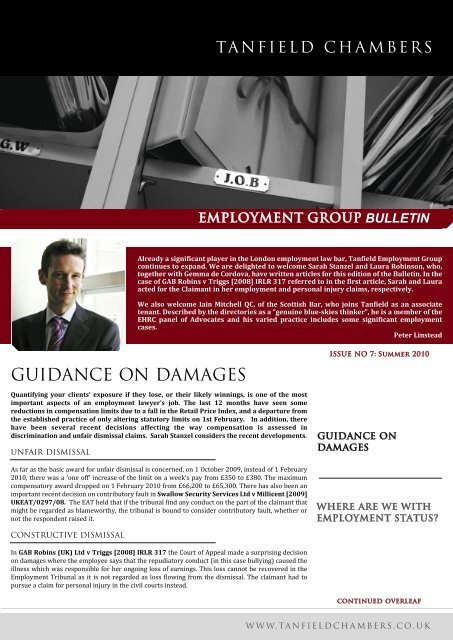
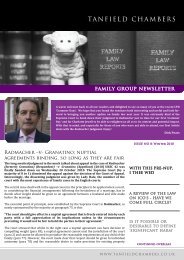


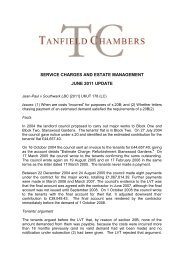
![Re Clarise Properties Ltd [2012] UKUT 4 (LC) - Tanfield Chambers](https://img.yumpu.com/36301708/1/190x245/re-clarise-properties-ltd-2012-ukut-4-lc-tanfield-chambers.jpg?quality=85)


